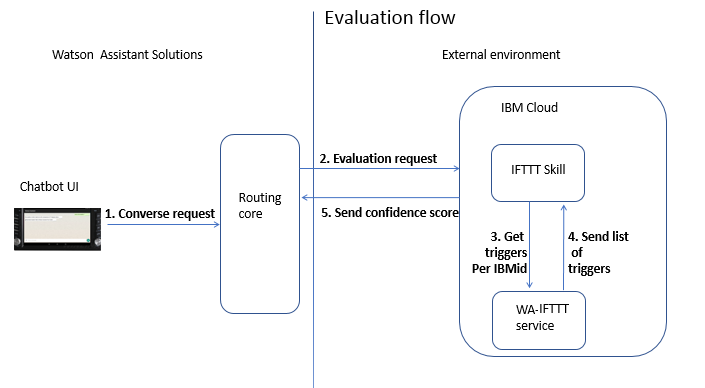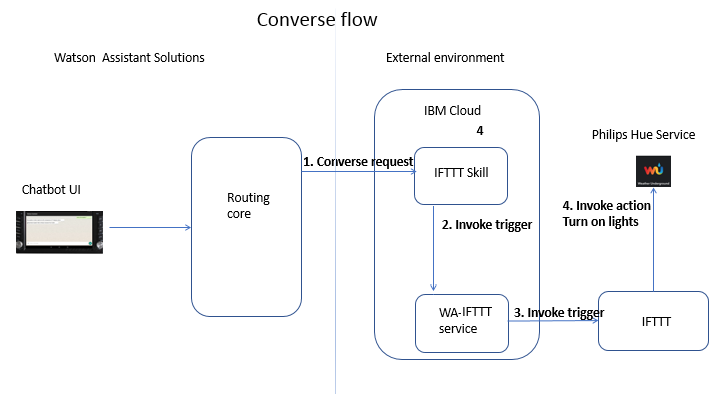How IFTTT rules works
When your end-user creates an applet on the IFTTT platform and uses your Watson Assistant Solutions service in the trigger, the IFTTT platform calls an IFTTT service to store a trigger for the user associated with the applet.
When an utterance that matches the trigger is received by Watson Assistant Solutions, it is sent to a dedicated IFTTT skill for processing. In response to the trigger, the skill invokes an action on the IFTTT platform through the IFTTT service.
Evaluation request
Figure 1 shows how an evaluation request is handled for an IFTTT trigger.
- A converse request that matches a trigger in an IFTTT applet is sent to the Watson Assistant Solutions core routing component.
- The core routing component sends the utterance to all skills for evaluation.
- The IFTTT skill requests the list of triggers for the user specified in the utterance from the IFTTT service.
- The IFTTT service sends the list of triggers.
- The IFTTT skill identifies an exact match for the trigger and returns a confidence score of 1 and the trigger ID to the core routing component.
Converse request
Figure 2 shows how a converse request is handled for an IFTTT trigger.
- The routing core component of Watson Assistant Solutions routes the utterance to the IFTTT skill for processing.
-
The skill executes the following
fire-triggeraction that is defined in theaction.jsfile. It passes the trigger ID that was passed in the evaluation response.'fire-trigger': (request, response, context) => { axios.post( iftttServiceEndpoint + "/invoke_wa_trigger", { trigger_id: request.evaluationResponse.response.triggerId }, { headers: { 'ifttt-skill-key': manifest['ifttt-skill-key'] } } ).then((response) => { }).catch((err) => { console.error("invoke_wa_trigger " + err.message); }); response.say(handler.t(request.evaluationResponse.response.triggerFields.answer)).send(); } - The fire-trigger action sends a request to the IFTTT service to trigger the action part of the rule.
- The IFTTT service triggers the IFTTT platform to execute the action part of the rule.
Adding IFTTT capability to your environment
To use the IFTTT capability in your environment, complete the following setup tasks:
- Create a developer account on the IFTTT platform.
- Configure and deploy an IFTTT service and its associated cloudant database to IBM Cloud. The service is an interface between Watson Assistant Solutions and the IFTTT platform. It is used to trigger user authentication, stores triggers for your Watson Assistant Solutions tenant, and calls the IFTTT platform to trigger actions. Register the details of the IFTTT service with the IFTTT platform.
- Configure and deploy an IFTTT skill in your environment, and register it with Watson Assistant Solutions. In the skill configuration, specify the URL of the IFTTT service on IBM Cloud and specify the same skill key that is used by the IFTTT service.
End-users can create applets on IFTTT that use the Watson Assistant Solutions in the trigger and another service in the action. You might also want to create pre-defined applets for your end-users to use.
Note: The sample IFTTT service configuration uses IBMid authentication, which is based on the OAuth 2.0 protocol, by default. You can use any other authentication mechanism that is based on OAuth 2.0.

